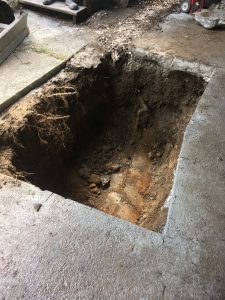I’ve always argued that all landscape professionals should be ISA certified arborists. It allows them to stay busy in winter with tree pruning and it also introduces more variety to their work days. They can also charge arborist rates which are higher than landscape rates.
And the best part? Extra income. Allow me to illustrate with one of my recent experiences. After reading this blog post, you might be tempted to get ISA certified. If that’s the case, contact me and I’ll help you prepare.
Tree babysitter
A friend referred me to a tank removal company. It turns out that municipalities require ISA certified arborists to be on site during excavations where trees are present. In this case there was only one tree which could potentially suffer damage, a giant Douglas fir (Pseudotsuga menziesii).
With DBH at 24 inches, the critical root zone extends 3.6 m away from the trunk. In this case, 3.6 m reached to the edge of a cement car port. The tank was buried under the car port but the mini-excavator worked on the lawn side, at drip-line.
Excavation Amigo
It was almost surreal getting paid to watch two young Mexicans jackhammer cement. The excavator did the rest. After a few hours the young dudes wondered what I was doing there, standing with a hard hat on, watching. Once I explained I was there to make sure nothing happened to the tree behind them, they wanted my job. Of course they did. It was a good gig with a good mission.
Other than watching the excavation, I also had to pick up the city permits in person and write two letters. The first letter lets the city know that a great ISA certified arborist will be on site to monitor the tree; and the final report shows that, in my professional opinion, there was zero impact on the tree.
Let’s recap: The critical root zone (3.6m from the trunk based on DBH of 24″) was never touched by the workers or machines. Remember, soil compaction silently kills trees; the first pass with an excavator does the most damage. This was news to the company owner.
When you compact a tree’s critical root zone you make it hard for fine surficial roots to collect water and nutrients. It might take several years for the tree to start declining.
Since all of the excavation took place at the edge of the dripline there was no damage. The tree obviously did well with the cement car port in place for many years. Any compaction would be on the lawn beyond the dripline.
I was extremely happy with my first tree babysitting gig. It was a good experience, both professionally and financially. And I’m confident the Douglas fir will easily outlive me.
Get ISA certified and reap the benefits!!





